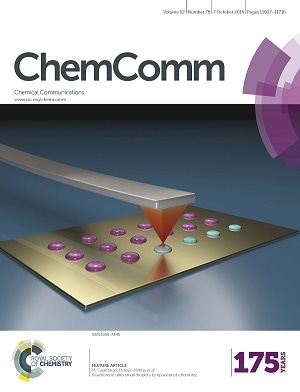Nov 16 2016
The Chemical Communications journal reviews the advances made towards the confinement of chemical reactions within small droplets. The focus of the article falls to the tip-assisted chemistry, a technique recently amended by the ICN2 Nanostructured Functional Materials Group.

In one of the latest issues of Chemical Communications, a journal devoted to novel and frontier research in chemistry, there is an article created by Prof. Daniel Ruiz-Molina and Dr Mireia Guardingo, from the ICN2 Nanostructured Functional Materials Group (NANOSFUN), together with Prof. Félix Busqué, from the Chemistry Department at Autonomous University of Barcelona (UAB).
The authors review the advances made towards the confinement of chemical reactions within small droplets assisted by the tip of an Atomic-Force Microscope (AFM). The publication, that became cover of the issue, recognizes two additional papers reported by the NANOSFUN group this year in the field.
In ACS Nano, a leading monthly journal of nanoscience and nanotechnology, the authors reported the synthesis of a coordination polymer, an organometallic structure, inside femtoliter droplets deposited on a surface.
The solutions of the metal salt and the organic ligand were independently transferred to adjacent tips of the same AFM probe array, and were sequentially delivered on the same position of the surface. The chemical reaction and the nanoparticle growth occur in situ, when the two droplets are mixed.
The ICN2 NANOSFUN Group also published another article in RSC Advances, an online-only journal that covers research on all aspects of the chemical sciences. In the paper, they reported the synthesis of a coordination polymer in femtolitre droplets on surfaces.
The results were compared with those obtained for the same reaction at different volume scales (femtoliters with an AFM, microliters with a pipette and millilitres with a beaker), in order to gain knowledge on the influence of the synthesis scale on the resulting characteristic of the material.
Even though this novel field is still in a basic science stage, the synthetic methodologies described in these manuscripts will open the door to the creation of novel nanostructures.
Due to the astonishing range of implications that derive from tip-assisted chemistry, there is an increasing interest on it. Different application areas can benefit from the reported studies: from molecular electronics to biosensors, among others.